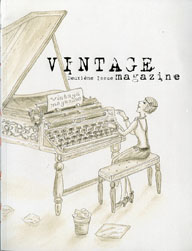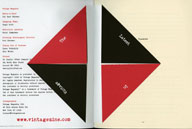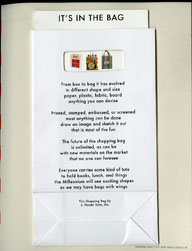
Think of Vintage magazine as a portable museum, beautiful, proficient and novel in every way, waiting for the visitors to enter and experience an ink on paper journey pampered with serendipity and loaded with creativity. The brainchild of Ivy Baer Sherman, the twice-yearly magazine was created in ” l’esprit de Flair” the Fleur Cowles legendary magazine that was published from Feb. 1950 to Jan. 1951 and was considered by many to be the showcase of what print should and can do: innovate, engage and experience.
 Every page of the magazine is an experience. The ink, the type, the pictures, the illustrations, the paper, the inserts and the binding all combine to take the reader through a breathless journey that cannot be any more captivating, intriguing and of course engaging.
Every page of the magazine is an experience. The ink, the type, the pictures, the illustrations, the paper, the inserts and the binding all combine to take the reader through a breathless journey that cannot be any more captivating, intriguing and of course engaging.
Vintage magazine is the proof positive that innovation in print is still alive, well and kicking. It is the proof positive that Ivy Baer Sherman’s dream of the “extraordinary physical draw of a magazine: the lure of stunning design; the striking sensation of ink on paper; the ravishing commingling of keenly-wrought words and fine art and editorial flair; the tactile quality of the read,” is fulfilled on each and every page of Vintage magazine.
 Armed with the first two issues of Vintage magazine in hand, I asked the curator of this portable museum, Ivy Baer Sherman, few questions as I journeyed through the pages of the magazine. What follows are my questions and her answers:
Armed with the first two issues of Vintage magazine in hand, I asked the curator of this portable museum, Ivy Baer Sherman, few questions as I journeyed through the pages of the magazine. What follows are my questions and her answers:
Samir Husni: In a world so consumed with digital, why start a print magazine and not only print, but one that can’t be replicated in any digital form?
Ivy Baer Sherman: Ah, yes, the world is indeed consumed with digital, but people are as concerned with the device providing the digital content. The winding lines wrapping around Apple stores from pre-dawn hours as people wait (WAIT! In this age when an extra second for a download seems interminable) to obtain the latest Apple-phenomenon (no matter the economy) are testament to the fact that the look and touch and feel of an actual object – especially when it is beautiful and proficient and novel in every way – still count.
Thus, though there are those who assert that the day of the print magazine has come and gone, people will take notice if a magazine is beautiful and proficient and novel in every way. This has been the response to Vintage Magazine. The time is ripe to showcase what a magazine can be and do.
SH: Vintage magazine is the Flair of the 21st Century, what made you fall in love with Flair and what inspired you to create a Flair-like magazine?
IBS: I was introduced to Flair at a 2003 retrospective of the magazine, “Fleur on Flair,” at the Pratt Manhattan Gallery. At first glance I was struck by Flair’s beauty …and promptly judged the magazine, as we are taught to never ever do, by its exquisite cover. The distinguishing feature of a Flair cover was a die cut—which offered an artful glimpse onto the world within. Turning the cover revealed further delights—foldouts and fabulous illustrations—by Saul Steinberg, by fashion designer Rene Gruau; riveting writing—Salvador Dali on his search for a gypsy angel, Tallulah Bankhead on Louis Armstrong; short stories by Tennessee Williams.
I left the show acutely attuned to the extraordinary physical draw of a magazine: the lure of stunning design; the striking sensation of ink on paper; the ravishing commingling of keenly-wrought words and fine art and editorial flair; the tactile quality of the read. I knew then and there that I wanted to create a magazine in l’esprit de Flair.
SH: The magazine is very costly to produce, from the sewn binding to the inserts and foldouts. Can you explain the process of “giving birth” to each issue of Vintage.

IBS: A key element of the process is serendipity. I never approach an issue with a pre-calculated theme…rather the personality of each issue gradually evolves during the editing process as articles are honed and begin to share space with each other and with the art pieces. I work closely with the printer (Capital Offset Company) throughout the process, running by him ideas about paper, die cuts, the binding…to assess feasibility. Using the current issue as example – an article about the history of shopping bags was given the title It’s In the Bag…thus why not print the piece as a brochure that pulls out of a little shopping bag? The shopping bag is glued onto a page of the magazine and can be pulled out and used. The piece on typewriters by jazz critic Gary Giddins prompted the use of typewriter-like stock, fonts and the insertion of hand-crumpled pages to bring to mind the old-fashioned “yank paper from the typewriter/crumple/toss” method of pre-computer editing. The open binding, a defining feature of the magazine, shows off the inner workings of a magazine, its spine, its physical foundation – and the binding is a nod to the creative collaboration of printer, graphic designer, and editor.
SH: What are you trying to accomplish with Vintage?
IBS: Vintage Magazine aims to bring to the fore, through the eloquent voices of today’s writers and artists, the impact of history on our present culture. That said, I see the magazine as portable museum, of sorts, offering writers and artists a venue in which to explore and present topics in new ways. In so doing, I hope to provide readers with an informative and truly delight-full reading experience.
SH: What advice you will give someone coming to you and saying ‘I would like to start a new magazine…’
IBS: Go for it! But with a desire to create and not to copy. To stay true to a vision. Blinders are sometimes in order. This is okay.
SH: What about the future? Any plans to increase frequency? Where do you see Vintage five years from now?
IBS: The two issues per year model is deliberate and steadfast. No need for a monthly Vintage… rather readers should sit down with each issue, explore it, feel it, read the articles leisurely, take notice, return to an article or image over the course of time…let the magazine ripen with age.
In terms of five years from now, I plan for the magazine to remain a twice-per year surprise. But I aim to offer a digital presence – not a replica of the print, but another Vintage venue in which to allow artists and writers to explore the possibilities of digital art, design and writing.
SH: Thank you.






















